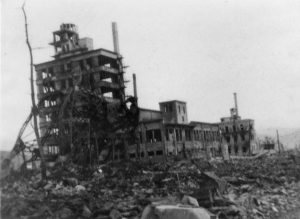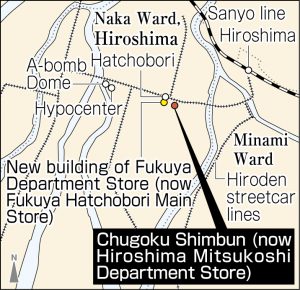Striving to fill voids in Hiroshima, evidence of victims remains—Seven photos of downtown devastation include shots taken around September 1945, shortly after atomic bombing
Aug. 6, 2022
Valuable photos taken by member of public
by Kyosuke Mizukawa, Staff Writer
Seven photographs of the devastation in Hiroshima City’s downtown area from the atomic bomb dropped by the U.S. military on August 6, 1945, have been sent to the Chugoku Shimbun by Hiroaki Shimoda, 95, an A-bomb survivor who lives in the city’s Nishi Ward. The photos were apparently given to Mr. Shimoda by his late uncle before he died. They include those taken around September 1945, which makes them relatively early photos among those taken after the atomic bombing and prior to the end of 1945. According to the Hiroshima Peace Memorial Museum, the photos are valuable for grasping the reality of the devastation caused by the atomic bombing. Mr. Shimoda has said he would donate the photos to the museum.
Five of the seven photos record scenes from around the Hatchobori area (now part of Hiroshima’s Naka Ward), which had been a bustling shopping district since before the war. They show the burned ruins around the new building of the Fukuya Department Store (now the Fukuya Hatchobori Main Store), located about 700 meters from the hypocenter, the incinerated building of the Chugoku Shimbun, which was located in the vicinity of the department store, and the bent and twisted steel frames of the Odamasa Store, a kimono wholesaler.
According to Mr. Shimoda and others, the photos were given to him about 40 years ago by his uncle, Tadao Nakano, who was from Hiroshima’s present-day Asakita Ward and died in 1992 at the age of 79. Since that time, Mr. Shimoda has kept the photos at his home. The photos are believed to have been taken by Mr. Nakano, who was 32 years old at the time of the atomic bombing. After reading the Chugoku Shimbun’s “Striving to fill voids in Hiroshima, evidence of victims remains,” a series of articles that describes the devastation of Hiroshima using images taken shortly after the atomic bombing and other materials, Mr. Shimoda thought that the photos might be of use and provided information about the images to the newspaper through family members.
After examining the seven photos, the museum indicated there was no previous record of the images. With respect to the photo of the Chugoku Shimbun’s new building, the museum took particular note that the broken windows had not yet been fitted with boards to protect the building from wind and rain. Since boards can be seen on the fourth floor of the building in a photo already confirmed to have been taken at the end of September, Mr. Shimoda’s photo appears to have been taken before then. From the locations the photos were taken and the circumstances of the city area revealed therein, the other photos are considered likely to have been taken around the same time.
Because of the chaos and shortages of goods and materials following the atomic bombing, not many citizens had the wherewithal to take photos related to the bombing, resulting in only a limited number of such photos. “Such a record left by a citizen during a time when it was difficult to obtain photographic film represents an extremely valuable set of materials for elucidating the reality of the atomic bombing,” said the museum. “The photographs are likely to have been taken relatively early, which is also important.”
(Originally published on August 6, 2022)









